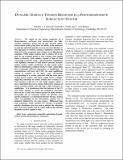Dynamic Surface Tension Behaviour in a Photoresponsive Surfactant System
Author(s)
Cicciarelli, Bradley A.; Smith, Kenneth A.; Hatton, T. Alan
DownloadMEBCS008.pdf (488.5Kb)
Metadata
Show full item recordAbstract
We report on the surface properties of a photoresponsive surfactant that incorporates the light-sensitive azobenzene group into its tail. Cis-trans photo-isomerization of this group alters the ability of the surfactant to pack into adsorbed monolayers at an air-water interface or into aggregates in solution, causing a significant variation in bulk and surface properties upon changes in the illumination conditions. NMR studies indicate that a solution left in the dark for an extended period of time contains trans isomer almost exclusively, while samples exposed to light of fixed wavelength eventually reach a photostationary equilibrium with significant amounts of both isomers present. Dynamic surface tension studies performed on this system under different illumination conditions (dark, UV light, visible light) show profoundly different approaches to equilibrium. At concentrations well above the CMC, the same equilibrium tension is reached in all three cases, presumably corresponding to a surface saturated with the trans (more surface active) isomer. The dark sample shows a simple, single-step relaxation in surface tension after creation of a fresh interface, while the UV and visible samples exhibit a more rapid initial decrease in tension, followed by a plateau of nearly constant tension, and end with a final relaxation to equilibrium. It is hypothesized that this behavior of the UV and visible samples is caused by competitive adsorption between the cis and trans isomers present in these mixtures. Presumably the cis surfactant reaches the interface more quickly, leading to a cis-dominated interface having a tension value corresponding to the intermediate plateau, but is ultimately displaced by the trans isomer. Diffusional time scale arguments which consider the extremes of possible micellar dissolution rates are used to analyze the relaxation data of the dark sample, and the results indicate that micellar dissolution in these samples is slow.
Date issued
2006-01Series/Report no.
Molecular Engineering of Biological and Chemical Systems (MEBCS)
Keywords
Azobenzene, competitive adsorption, dynamic surface tension, photoresponsive surfactants